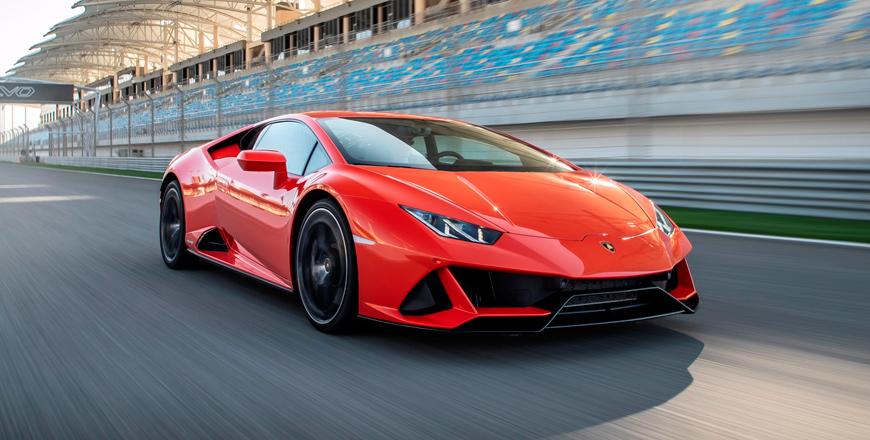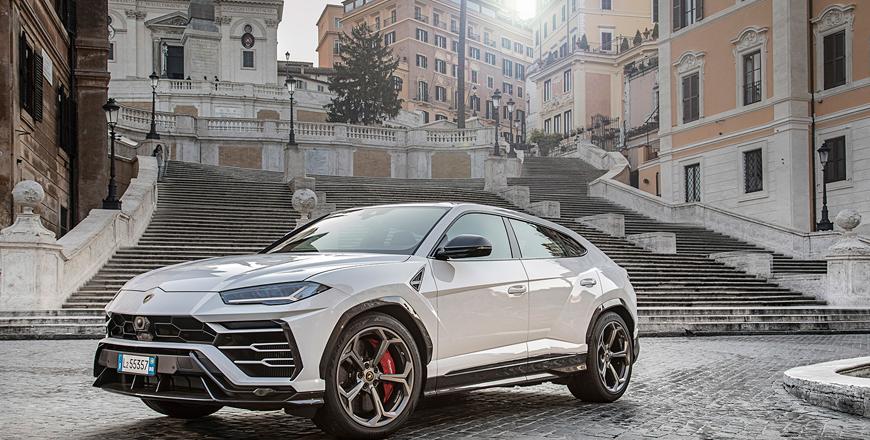You are here
Lamborghini Huracan Evo Spyder: Engaging, engrossing, exhilarating
By Ghaith Madadha - Feb 07,2022 - Last updated at Feb 07,2022

Photo courtesy of Lamborghini
The refreshed ragtop version of the iconic Italian automaker’s “junior” supercar line, the Lamborghini Huracan Evo Spyder’s revisions go beyond just an aesthetic update, but are instead substantive enough to wholly warrant the “evolution” moniker added to it nameplate.
Introduced in 2019, the Huracan Evo Spyder gains improved performance and an updated and more user-friendly infotainment system. In addition to sharper styling updates, the Evo’s handling abilities and responses are more importantly significantly improved, with the addition of four-wheel-steering, revised electronic driving dynamic integration and enhanced aerodynamics.
Dialling up the drama with revised styling, the Evo exudes the same viscerally urgent athleticism with jutting edges, sharp lines and low and wide road-hugging stance. Emphasising the horizontal plane, its new bumper features triangular front cooling ducts, while sill-mounted side intakes are similarly re-styled. With its fabric roof electrically folding back in 17-seconds at up to 50km/h, the Evo Spyder retains its visual momentum with twin top-down mode flying buttress-like fins behind the seats that also fluently integrate the high-set rear deck and broad, muscular haunches.
Evolved and enhanced
Redesigned for improved aerodynamics, the Huracan Evo utilises lessons learned from the pre-facelift Huracan Performante variant, but implements them here without the earlier car’s complex active air flow management system. Instead, the Evo Spyder achieves much improved down-force and five times better aerodynamic efficiency than the pre-facelift Huracan, with fixed underbody airflow management and a slotted, raised and integrated rear spoiler. Built using stiff and lightweight aluminium and carbon-fibre construction, the Spyder, however, gains 120kg over the fixed-head Huracan, owing to compensating structural stiffening and its folding roof mechanism.
Inheriting the pre-facelift high output Performante model’s up-rated version of Lamborghini’s superb mid-mounted, dry sump, naturally-aspirated 5.2-litre V10 engine, the Evo Spyder may, however, be at a marginal performance disadvantage to its lighter current hard-top coupe sister model. But with 631BHP peaking at a searing 8,000rpm and 442lb/ft torque available at 6,500rpm, the 0.2-second slower acceleration time is negligible. Up 30BHP over its direct Spyder predecessor, the 1,542kg Evo Spyder is sensationally swift, rocketing through 0-100km/h in 3.1 seconds, 0-200km/h in 9.3-seconds and onto a 325km/h top speed.
Snarling and surging
Responsive from idling to redline, the Evo sweeps through revs in a seamlessly scintillatingly swift manner and vicious alacrity. Free-revving and urgent, the Evo delivers scalpel-sharp reflexes and responsiveness to accurately unleash exacting increments of power and conversely wind down with near immediacy. Viscerally engaging, the Evo’s soundtrack coalesces from mechanical staccato to resonant metallic snarl, and surges to a wailing howl. Though high-strung, the Evo nevertheless digs deep from low revs and delivers muscular mid-range flexibility, with 70 per cent of maximum torque on tap from just 1,000rpm.
Concisely quick yet slick shifting, the Evo’s 7-speed dual-clutch automated gearbox features different settings for escalating response levels, and fixed column-mounted manual mode paddle-shifters. With a rear bias, the Huracan Evo’s four-wheel-drive provides tenacious off the line traction but can also alter rear-to-front power distribution, and sideways on the rear axle through a limited slip differential, for unimpeachable stability, vice-like grip and mosquito-like agility. Sure-footed yet nimble, the Evo’s brake-based torque vectoring further enhances turn-in agility, while tirelessly effective ventilated, perforated carbon ceramic discs deliver 32.2 metre 100-0km/h braking.
Focused reflexes
Engagingly exhilarating with near telepathic reflexes and driver immersion, the Evo precisely reacts to the smallest input, conveying the feeling of driver connection, control and confidence. Driving with the nimble manoeuvrability of a small sports car, the Evo’s adoption of four-wheel-steering is transformative in the level of agility gained over its predecessor. Turning front wheels opposite to rear at low speed and in the same direction at higher speed, four-wheel-steering effectively shortens or lengthens its wheelbase and delivers crisp turn-in immediacy and the ability to change direction at whim.
Complementing this is a new generation central processing vehicle dynamic system that monitors various inputs and predicts dynamic attitudes. Seamlessly adjusting adaptive dampers, four-wheel-drive, torque vectoring and traction control settings, the Evo’s processing system even directs traction to one wheel if necessary. On road, the Evo is tidy into and balanced throughout corners with its slightly rear-biased within-wheelbase weighting, while adaptive dampers provide poised body control. With enormous 305/30R20 rear tires, the Evo meanwhile exits corners with commitment, but is nevertheless willing to adjust cornering lines on command.
Settled and supportive
Settled and hunkered down at speed and in vertical movements, the Evo’s four-wheel-steering meanwhile provides enhanced lane change stability at higher speeds. Smooth and comfortable as open top supercars come, the Evo Spyder provides good front visibility, while a reversing camera compensates for limited rear visibility, and four-wheel-steering helps make parking easier. Well-insulated for road noise with the soft-top up, the Evo Spyder, however, reduces wind buffeting during open top driving, with the use of ducts positioned between its buttress fins.
Driver-focused in style and layout inside, with supportively bolstered seats and plenty of Alcantara and leather, the Evo Spyder’s letter-slot rear window meanwhile lowers to allow a more vocal rendition of its engine’s sonorous soundtrack. Snug but well-spaced for a supercar — with practical 100-litre under-bonnet storage — the Evo Spyder acceptably accommodates even taller drivers, but slightly improved headroom would still be welcome. Well-equipped with safety and convenience features, including hidden pop-up roll-bars, the Evo’s improved infotainment system features an 8.4-inch vertical touchscreen and enhanced connectivity and voice activation.
TECHNICAL SPECIFICATIONS
Engine: 5.2-litre, mid-mounted, dry sump, V10-cylinders
Bore x stroke: 84.5 x 92.8mm
Compression ratio: 12.7:1
Valve-train: 40-valve, DOHC, direct injection
Gearbox: 7-speed automated dual clutch
Driveline: Four-wheel-drive, double-plate clutch, mechanical self-locking rear differential
Power, BHP (PS) [kW]: 631 (640) [470] @8,000rpm
Specific power: 121.3BHP/litre
Power-to-weight: 409.2BHP/ton
Torque, lb/ft (Nm): 442 (600) @6,500rpm
Specific torque: 115.3Nm/litre
Torque-to-weight: 389.1Nm/ton
0-100km/h: 3.1-seconds
0-200km/h: 9.3-seconds
Top speed: 325km/h
Fuel consumption, combined: 14.2-litres/100km
CO2 emissions, combined: 338g/km
Fuel capacity: 83-litres
Length: 4,520mm
Width: 1,933mm
Height: 1,180mm
Wheelbase: 2,620mm
Track, F/R: 1,668/1,620mm
Dry weight: 1,542kg
Weight distribution, F/R: 43 per cent/57 per cent
Luggage volume: 100-litres
Steering: Electric-assisted rack & pinion, all-wheel steering
Turning circle: 10.9-metres
Suspension: Double wishbones, optional adaptive magnetic dampers
Brakes, F/R: Ventilated, perforated carbon-ceramic discs 380 x 38mm/356 x 32mm
Brake callipers, F/R: 6-/4-piston calipers
Braking distance, 100-0km/h: 32.2-metres
Tyres, F/R: 245/30R20/305/30R20
Related Articles
Historically playing second fiddle to Lamborghini’s glamorous V12 supercars, the Italian carmaker’s 1972-88 Urraco, Silhouette and Jal
Winner of the 2020 Middle East Car of the Year’s Best Performance Coupe prize and runner up for the top award, the Lamborghini Huracan Evo f
Purveyors of extreme machines almost from the outset, Lamborghini could credibly be credited with defining both the modern supercar’s mid-en



















